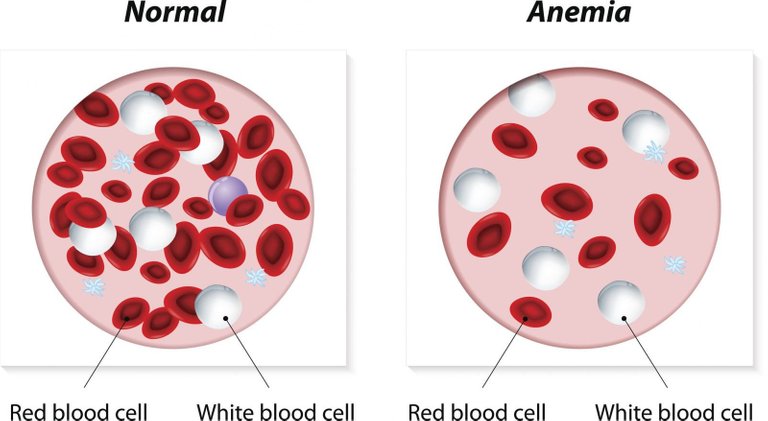Anemia; Types, causes, risk factors, symptoms, and treatment.

Image edited on canva
Greetings to everyone, I'm happy to be making a return to the blockchain with this article, its a pleasure. My
Introduction
Over the years, food scientists have discovered that vegetarians are more likely to develop a certain kind of blood disease, this is due to the absent of folate rich edible like meat in their diet. This disease affects the whole body, causing fatigue and weakness. Its known as anemia.
What is anemia
Anemia is a blood disorder characterised by decreased level of red blood cells in circulation. It develops due to a preexisting health issue that affects the production of the red blood cell in the body. It can also arise as a result of always eating low iron containing foods like diary.
Anemia is the commonest blood disorder that has plagued about one third of the world population in one form or the other. Low level of red blood cells signifies a low hemoglobin level in the blood, low hemoglobin level in turn signifies a low oxygen level in the blood, this can lead to the breakdown of vital organs in the body since the cells require oxygen to perform its different functions in the body.
Types of anemia
Aplastic anemia: This type of anemia occurs as a result of inability of the bone marrow to produce red blood cells, possibly due to the damage of the bone marrows. It causes symptoms like skin rashes and fever.
Hemolytic anemia: This type of anemia develops as a result of premature destruction of the erythrocytes. This can manifest as jaundice, abdominal pains and dark urination.
sickle cell anemia: This is an inherited type of anemia characterised by abnormal shape of the red blood cell, it is very fatal and may sometimes result in death.
Folic acid deficiency anemia: This type of anemia develops due to lack or insufficient level of vitamin B12 and folic acid in the body.
Symptoms
The symptoms of anemia varies depending on the cause of the anemia, some are mild, others severe.
The symptoms include;
- Headache
- fast or unusual heart beat
- paleness of the skin
- fatigue and weakness
- difficulty walking
- numbness
- colds hands and feet
- Shortness of breadth
- Problem of coordination
- peeling of the tongue
- glossitis
Risk factor
Some of the factors that are capable of predisposing one to anemia includes;
- consuming poor meals or diets lacking essential vitamins and minerals
- chronic disorders like cancers and kidney failure can lead to shortage of red blood cell, hence predisposing the individual to anemia
- women who are on menstruation, this is because menstruation results in loss of RBC.
- Intestinal disorders like crohn's disease that inhibits the absorption of nutrients can also play a significant role in the onset of anemia.
- family history also plays a great role in the onset of anemia.
- Individuals greater than 65years of age are at higher risk of developing anemia.
Treatment
Treatment options usually depends on the type of anemia diagnosed and it severity.
In cases of aplastic anemia, blood transfusion remains the only available option since the bone marrow is damaged
For hemolytic anemia, medications that can suppress the immune system (betamethasone) can be administered to limit the prematured destruction of red blood cell.
Sickle cell anemia is a complicated one that will demand plethora of drugs like oxyurea, analgesics, supplements and antibiotics to effectively manage it.
Conclusion
Anemia is a very serious blood disorder that must be avoided at all cost. In this case, prevention is the best option as most anemic conditions are very difficult and expensive to treat.
Among the various types of anemia, sickle cell anemia is the most complicated since its genetically linked. In case you start experiencing any of the aforementioned symptoms, don't hesitate to visit a nearby laboratory for a diagnostic test.
Thanks for reading.
